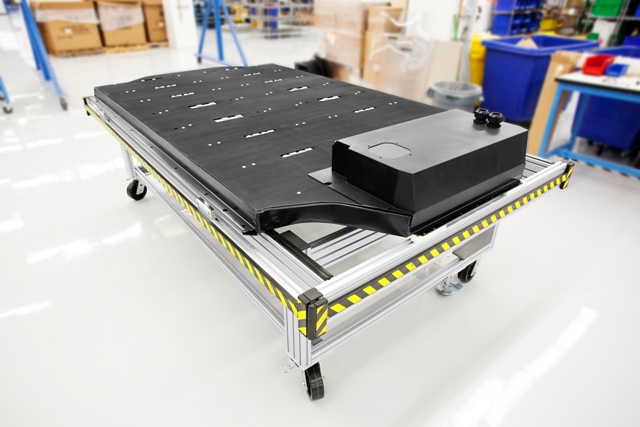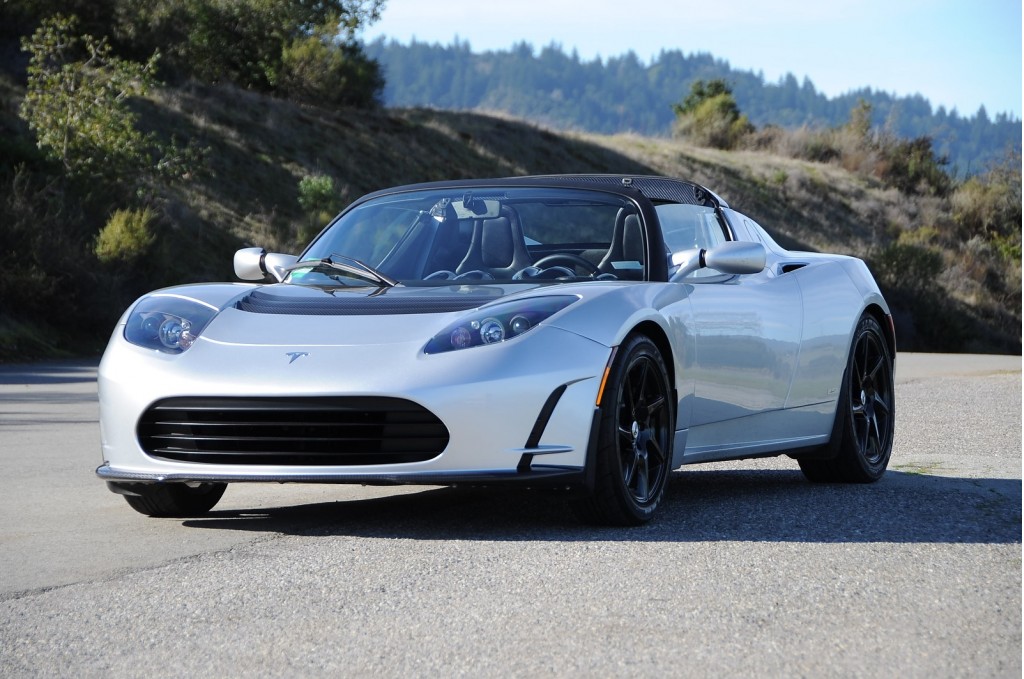One of the things electric-car owners worry about is long-term battery degradation.
It’s a well-established fact that lithium-ion batteries gradually lose capacity as they undergo numerous charge/discharge cycles.
We owners understand that our range will gradually decline over the life of the car. The critical question is how much.
DON'T MISS: 2014 Tesla Model S P85D: First Drive Of All-Electric AWD Performance Sedan
My 2013 Tesla Model S, when new, had an EPA range of 265 miles. But six or eight years down the road, with 100,000-plus miles on the odometer, there’s no way to know what my range will be.
It’s an especially worrisome question for Model S owners, for two reasons:
First, the list price of a replacement 85-kWh battery pack is a whopping $44,000. (That cost would presumably be reduced by the trade-in value of the old pack, a number that has not been publicly revealed as far as I know.)

Tesla Motors - Model S lithium-ion battery pack
By contrast, a Nissan Leaf replacement battery costs $5,500, after the trade-in allowance.
Second, it’s a little-noticed fact that Tesla’s eight-year “infinite-mile” battery-pack warranty doesn’t actually guarantee any particular level of capacity. It only guarantees that the battery will work properly to propel the car.
ALSO SEE: Nissan Leaf Battery Capacity Loss: Covered By Warranty, Now (Dec 2012)
So if I lose half my battery capacity and range after three years, it would be tough luck for me.
As long as the battery doesn’t short out or malfunction, Tesla has no obligation to replace it, no matter how much capacity is lost.

2015 Nissan Leaf
Again, the Leaf provides a stark contrast.
In the wake of more-rapid-than-expected battery capacity losses in Leafs in hot weather, Nissan now guarantees that the Leaf battery will retain at least 70 percent capacity after five years and/or 60,000 miles.
Nissan is the only company to guarantee long-term battery capacity.
Reason for optimism
Only time will tell, of course, what the rate of battery degradation and range loss will be for electric cars currently on the road.
But for the Model S at least, there’s reason for optimism.

2011 Tesla Roadster Sport. Photo by Joe Nuxoll.
Range losses for its two-seat predecessor, the Tesla Roadster, have proven to be less than expected since it was introduced in 2008.
And a recent unofficial study by a Dutch engineering professor shows an average range loss for the Model S even less than the Roadster’s. (Not surprising; the Model S battery management system is more sophisticated than the Roadster’s.)
Roadster data
When Tesla first introduced the Roadster in 2008, it predicted that the battery pack would retain at least 70 percent of its capacity after five years and 50,000 miles of driving.
But in reality, the car has done much better than that.
RELATED: Battery Life In Tesla Roadster Is Likely Better Than Predicted (Jul 2013)
In 2013, Plug In America did a study of Tesla Roadster battery longevity.
Using data from 126 Roadsters driven a total 3.2 million miles, the study concluded that the typical Roadster would still have 80-85 percent battery capacity after 100,000 miles.
![Tesla Model S electric-car road trip, upstate New York to southern California [photo: David Noland] Tesla Model S electric-car road trip, upstate New York to southern California [photo: David Noland]](https://images.hgmsites.net/lrg/tesla-model-s-electric-car-road-trip-upstate-new-york-to-southern-california-photo-david-noland_100500012_l.jpg)
Tesla Model S electric-car road trip, upstate New York to southern California [photo: David Noland]
Model S data
The recent Model S numbers from The Netherlands are even more encouraging.
Based on 84 data points from the 85-kWh version of the Model S and six from 60-kWh cars, the study concludes that the Model S will retain about 94 percent of its capacity after 50,000 miles, with losses thereafter shrinking to about 1 percent per 30,000 miles.
That means that after 100,000 miles, the typical Model S is projected to retain about 92 percent of its battery capacity and range.
![Tesla Model S electric-car road trip, upstate New York to southern California [photo: David Noland] Tesla Model S electric-car road trip, upstate New York to southern California [photo: David Noland]](https://images.hgmsites.net/lrg/tesla-model-s-electric-car-road-trip-upstate-new-york-to-southern-california-photo-david-noland_100500017_l.jpg)
Tesla Model S electric-car road trip, upstate New York to southern California [photo: David Noland]
That translates to a range loss of only about 21 miles, from 265 to 244 miles.
The highest-mileage car in the study, which had about 52,000 miles on it, still retained about 94 percent of its battery capacity and range.
Plug-In America has also been gathering data for a range-loss study of the Model S.
Tom Saxton, its chief science officer and the author of the earlier Roadster study (he’s also a Roadster owner), reports that his preliminary results show that a Model S85 is projected to retain about 90 percent battery capacity until 86,000 miles.
![Tesla Model S electric-car road trip, upstate New York to southern California [photo: David Noland] Tesla Model S electric-car road trip, upstate New York to southern California [photo: David Noland]](https://images.hgmsites.net/lrg/tesla-model-s-electric-car-road-trip-upstate-new-york-to-southern-california-photo-david-noland_100500016_l.jpg)
Tesla Model S electric-car road trip, upstate New York to southern California [photo: David Noland]
According to Saxton’s data, the S60 version, whose smaller battery must undergo more charge/discharge cycles to travel the same distance, retains 90 percent capacity to about 67,000 miles.
The high-mileage car in the ongoing PIA study had 92,000 miles as of last summer, and still retained 92 percent of battery capacity.
Hopefully the final PIA Model S report will be issued soon. We look forward to reading it.
![2014 Tesla Model S P85D, road test, Dec 2014 [photo: David Noland] 2014 Tesla Model S P85D, road test, Dec 2014 [photo: David Noland]](https://images.hgmsites.net/lrg/2014-tesla-model-s-p85d-road-test-dec-2014-photo-david-noland_100494830_l.jpg)
2014 Tesla Model S P85D, road test, Dec 2014 [photo: David Noland]
Just an average
All these numbers are averages, of course; your battery degradation may vary.
It’s widely believed that always charging the battery to 100 percent will cause faster long-term battery degradation. That’s why Tesla allows owners to set their max charge level to any lesser percentage they prefer.
MORE: Tesla P85D Highlights Why EPA Range Ratings Are Inconsistent & Confusing For Electric Cars
Due to a misguided EPA testing protocol, Nissan has eliminated the option of less-than-100-percent charging in 2014 and later model Leafs. Likewise, the BMW i3 also does not offer the partial-charging option.
It’s also been speculated that heavy use of ultra-fast DC chargers, such as the Tesla Superchargers and CHAdeMO charging stations, may reduce battery life as well, though we’ve seen no definitive data on this.
![Solar panels at Supercharger in Barstow, CA, during Tesla Model S road trip [photo: David Noland] Solar panels at Supercharger in Barstow, CA, during Tesla Model S road trip [photo: David Noland]](https://images.hgmsites.net/lrg/tesla-model-s-electric-car-road-trip-upstate-new-york-to-southern-california-photo-david-noland_100500010_l.jpg)
Solar panels at Supercharger in Barstow, CA, during Tesla Model S road trip [photo: David Noland]
But all in all, the foregoing numbers suggest that, if you don’t habitually charge to 100 percent and don’t overdo the DC fast charging, the prospects for an electric car’s long-term battery capacity and range look pretty good.
I know I’m breathing easier these days. After 32,000 miles, I’ve noticed no range loss at all.
And if the Dutch projections are accurate, a Model S battery capacity loss of only six percent after 100,000 miles is something I can easily live with--and better than I expected when I bought the car.
_________________________________________________












